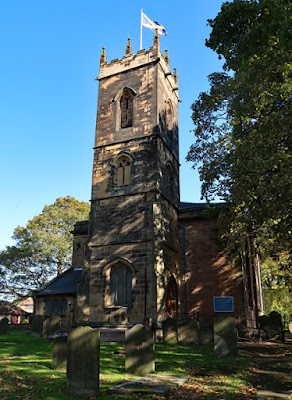 |
| The west elevation of St. Alban's church |
When undertaking my investigation of mediaeval churches in Rotherham, starting with St. Helen’s church in Treeton back in February 2016, St. Alban’s church wasn’t on my list of those to visit – mainly because I only remembered the late Georgian aisleless nave (1834) by John Lister, on the only occasion that I had previously visited this part of Wickersley.
Having taken the time to have a better look at the church, during my brief survey of the historic buildings and geology of Wickersley, and since undertaking research that includes reference to Roddis - Quarries of Wickersley 1767 – 1962, which I borrowed from Wickersley Library after finishing my walk, I have since learned that a church in Wickersley dates back to at least 1177 – probably around 1150 according to the church website.
Starting at the west tower, the only part of the mediaeval church that remains from the complete re-building by Roger de Wickersley in the C15, I immediately noticed the differences between the condition of the masonry used for the lower 3 stages of the Perpendicular Gothic style C15 tower and the C19 addition, whose date is not recorded.
Although quite blackened, Wickersley Rock appears to have been used throughout, but the original masonry is very weathered and reflects the soft nature of this sandstone, which made it particularly suitable for making grindstones. A substantial amount of the C15 masonry has been replaced with a uniformly buff coloured sandstone which, based on a report on the Wickersley Rock provided by the British Geological Survey back in 1989, could be Bolton Woods stone from Bradford.
Looking more closely at the stonework of the tower at ground level, the sandstone has Liesegang rings that have developed into thin bands of dense ironstone, which is a characteristic of the Wickersley Rock that I didn’t see when photographing the historic buildings and boundary walls on and around Morthen Road.
The adjoining nave is built in a sandstone that does not have Liesegang rings or ironstone bands and is mainly light red in colour with yellow and some mottled variations. This reminds me of the red/yellow Rotherham Red sandstone that I had seen in many churches and vernacular buildings and boundary walls, when exploring the villages between Treeton and Harthill, but I have not encountered this variety in any of the quarries and natural exposures that I have seen.
Walking anti-clockwise around the exterior of the church, I could see that the same stone has been used for all of the Victorian additions, including the chancel (1886), and I noticed a smattering of small clay ironstone nodules in one of the blocks on the north wall; however, although such ironstone nodules are very common in the Rotherham Red sandstone, these are not a characteristic feature of the stone used here.
Interestingly, Roddis - Quarries of Wickersley makes a reference to a talk given by Rev. T. Riby, the vicar of All Saints church in Laughton-en-le-Morthen, where it is suggested that the red sandstone used in the north Saxon door is from Wickersley and which is presumably based on knowledge that red sandstone was quarried.
The source of the sandstone is a bit of a mystery that deserves further investigation and, the next time I am in Wickersley, I will take another closer look. Although I had discovered red sandstone in a field to the north of Second Lane, apart from one small quarry at the southern edge of Wickersley Wood, all of the quarrying took place to the west side of Morthen Road and to the north of the Bawtry Road.
During my brief exploration of the historic architecture in Wickersley, the only building that I saw that is built of predominantly red sandstone that is similar to the one used for the church is at No. 50 Morthen Road. Apart from the those in the Listerdale Estate, only one old quarry now remains in Wickersley, next to Almond Glade, which I have been informed does not have red sandstone.
One very unusual feature of the church is the incorporation of several headstones into the fabric of the chancel, which were thought to have been disturbed during its construction, and others have also been used in the north elevation.
Having a wander around the churchyard, I photographed the Grade II Listed early C18 grave slab dedicated to various members of the Bower family and the remains of a mediaeval coffin, made of Permian dolomitic limestone and probably dating to the C15.
I usually find something to interest me as as a geologist, when exploring churchyards, and amongst the various stones seen here I found some good examples of the weathering of sandstone, which highlights their value for education in the Earth Sciences.
Another headstone that caught my eye is another example of red sandstone, which again looks like Rotherham Red sandstone and it is the only example that I have seen of this locally distinctive stone being put to such a use.














No comments:
Post a Comment